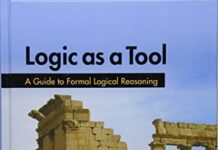
Ebook Info
- Published: 2016
- Number of pages: 384 pages
- Format: PDF
- File Size: 2.71 MB
- Authors: Valentin Goranko
Description
Written in a clear, precise and user-friendly style, Logic as a Tool: A Guide to Formal Logical Reasoning is intended for undergraduates in both mathematics and computer science, and will guide them to learn, understand and master the use of classical logic as a tool for doing correct reasoning. It offers a systematic and precise exposition of classical logic with many examples and exercises, and only the necessary minimum of theory.The book explains the grammar, semantics and use of classical logical languages and teaches the reader how grasp the meaning and translate them to and from natural language. It illustrates with extensive examples the use of the most popular deductive systems — axiomatic systems, semantic tableaux, natural deduction, and resolution — for formalising and automating logical reasoning both on propositional and on first-order level, and provides the reader with technical skills needed for practical derivations in them. Systematic guidelines are offered on how to perform logically correct and well-structured reasoning using these deductive systems and the reasoning techniques that they employ.Concise and systematic exposition, with semi-formal but rigorous treatment of the minimum necessary theory, amply illustrated with examplesEmphasis both on conceptual understanding and on developing practical skillsSolid and balanced coverage of syntactic, semantic, and deductive aspects of logicIncludes extensive sets of exercises, many of them provided with solutions or answersSupplemented by a website including detailed slides, additional exercises and solutionsFor more information browse the book’s website at: https://logicasatool.wordpress.com
User’s Reviews
Editorial Reviews: Review “Classical logic is hard but rewarding―helping with clarity in programming, business decisions, and whatever life throws at you….” (MagPi, Jan 17) From the Inside Flap A concise and systematic guide for understanding and using classical logicThis textbook, written in a user-friendly style, will guide students to learn, understand and master the use of classical logic as a tool for doing correct reasoning. It offers a systematic and precise exposition of classical logic with many examples and exercises, and only the necessary minimum of theory..The book explains the grammar, semantics and use of classical logical languages and teaches the reader how grasp the meaning and translate them to and from natural language. It illustrates with extensive examples the use of the most popular deductive systems — axiomatic systems, semantic tableaux, natural deduction, and resolution — for formalising and automating logical reasoning both on propositional and on first-order level, and provides the reader with technical skills needed for practical derivations in them. Systematic guidelines are offered on how to perform logically correct and well-structured reasoning using these deductive systems and the reasoning techniques that they employ. Key Features: Concise and systematic exposition, with semi-formal but rigorous treatment of the minimum necessary theory, amply illustrated with examples. Emphasis both on conceptual understanding and on developing practical skills. Solid and balanced coverage of syntactic, semantic, and deductive aspects of logic. Includes extensive sets of exercises, many of them provided with solutions or answers. Supplemented by a website including detailed slides, additional exercises and solutions. Written in a clear, precise and user-friendly style, Logic as a Tool: A Guide to Formal Logical Reasoning is intended for undergraduates in both mathematics and computer science, but will also be useful for students studying philosophy. From the Back Cover A concise and systematic guide for understanding and using classical logicThis textbook, written in a user-friendly style, will guide students to learn, understand and master the use of classical logic as a tool for doing correct reasoning. It offers a systematic and precise exposition of classical logic with many examples and exercises, and only the necessary minimum of theory.The book explains the grammar, semantics and use of classical logical languages and teaches the reader how grasp the meaning and translate them to and from natural language. It illustrates with extensive examples the use of the most popular deductive systems — axiomatic systems, semantic tableaux, natural deduction, and resolution — for formalising and automating logical reasoning both on propositional and on first-order level, and provides the reader with technical skills needed for practical derivations in them. Systematic guidelines are offered on how to perform logically correct and well-structured reasoning using these deductive systems and the reasoning techniques that they employ.Key Features:Concise and systematic exposition, with semi-formal but rigorous treatment of the minimum necessary theory, amply illustrated with examples.Emphasis both on conceptual understanding and on developing practical skills.Solid and balanced coverage of syntactic, semantic, and deductive aspects of logic.Includes extensive sets of exercises, many of them provided with solutions or answers.Supplemented by a website including detailed slides, additional exercises and solutions.Written in a clear, precise and user-friendly style, Logic as a Tool: A Guide to Formal Logical Reasoning is intended for undergraduates in both mathematics and computer science, but will also be useful for students studying philosophy. About the Author Valentin Goranko is an associate professor at the Department of Applied Mathematics and Computer Science of the Technical University of Denmark. He has had over 25 years of University teaching and research experience: in particular, he has taught several courses partly based on the proposed book. Read more
Reviews from Amazon users which were colected at the time this book was published on the website:
⭐
⭐
Keywords
Free Download Logic as a Tool: A Guide to Formal Logical Reasoning 1st Edition in PDF format
Logic as a Tool: A Guide to Formal Logical Reasoning 1st Edition PDF Free Download
Download Logic as a Tool: A Guide to Formal Logical Reasoning 1st Edition 2016 PDF Free
Logic as a Tool: A Guide to Formal Logical Reasoning 1st Edition 2016 PDF Free Download
Download Logic as a Tool: A Guide to Formal Logical Reasoning 1st Edition PDF
Free Download Ebook Logic as a Tool: A Guide to Formal Logical Reasoning 1st Edition
